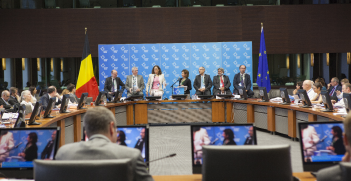Should India Be in APEC? The Indo-Pacific Answers

In APEC’s 30th year, and six months before the 2019 APEC Summit, a new report brings the region’s perspectives on the case for India’s accession to this premier economic forum.
The first meeting of APEC was held in November 1989, ten months after then-Australian Prime Minister Bob Hawke called for its formation to help ease pressures on the international trading system. The inaugural meeting occurred just days prior to the fall of the Berlin Wall.
Much has changed since then.
With United States predominance in a post-Cold War world, US-encouraged trade liberalisation and industrialisation shifted the world’s economic centre of gravity towards Northeast Asia and the broader Asia-Pacific region. As China and Southeast Asia’s “tiger economies” began a process of rapid urbanisation and development, APEC matured into the region’s preeminent piece of economic architecture.
Three decades on, further reorganisations of economic and strategic power are occurring. The strategic predominance of the US is narrowing, particularly in Asia, reflecting the rise of China to great power status: arguably this century’s most consequential development. The international trading system is again under pressure, made most visible by the US-China trade war and the inability of APEC leaders in late 2018 to reach communique consensus.
And of course, there is the inexorable rise of India. As the world’s fastest growing major economy, India is predicted to boast an economy equivalent in size to the US by 2030, and become the second largest economy in the world by 2050. It is in recognition of India’s growing strategic clout and economic significance that a number of countries have extended the Asia-Pacific construct west, to acknowledge India within a broader Indo-Pacific region.
However, at an economic and institutional level, the Indo-Pacific is still “under construction.” India is absent from APEC, which both contributes to and reflects its yet-complete integration with Indo-Pacific economies. With the Indo-Pacific in need of effective institutions to formulate and abide by the rules of the road on trade and liberalisation, the rationale for and implications of Indian accession to APEC have again been considered.
A recent special report by the Perth USAsia Centre, India in APEC: Views from the Indo-Pacific, has provided new regional perspectives on this issue. Bringing together a number of emerging and established scholars from India and six APEC economies — Australia, Indonesia, Japan, Malaysia, Singapore and Vietnam — the report unpacks the varied range of interests, objectives and agendas informing national perspectives on this question.
Most importantly, the report reveals a common thread of analysis: it is in the strategic and economic interests of Indo-Pacific nations to have India in APEC. Many of the regional analysts state that India’s emergence as a great power means it should be included in the region’s premier economic forum, and that Indian membership could help balance emerging tensions within APEC and across the region.
In APEC’s 30th year, the report showed concerns about the institution’s ongoing capacity to facilitate economic cooperation. This raises questions that go to the heart of APEC’s purpose: if the consensus-driven organisation is unable to fulfil its mandate in a time of geopolitical uncertainty, is it still relevant? Authors note the long road ahead for APEC to achieve its goal of a region-wide free trade area, and ask whether changing strategic and economic currents in the Indo-Pacific are leaving APEC — in its current form — behind.
In response, Indian accession to APEC has been advanced as an answer to these grand challenges. As a power growing in national and diplomatic confidence, and with an ever-increasing share of global GDP, India is now a vital actor in regional affairs. As a supporter of an open and inclusive rules-based international order, many analysts argue Indian membership would bolster APEC’s dialogue-driven processes. While authors acknowledge Indian inclusion could challenge APEC’s traditional geographic remit, they argue Indian membership would enable APEC to mature into a truly Indo-Pacific institution. Scholars also highlight the significant market access opportunities an APEC-wedded India would provide their nations, with India knitted into the regional economic system and its liberalisation agenda likely furthered.
Analysts also fully acknowledge India’s liberalisation will continue to occur in its own time and on its own terms, and that market risks and trade negotiation challenges with India still exist. Yet, authors canvass India’s increasing cognisance of its need to enhance its trade and investment ties, as well as liberalise markets for its consumers and labour force. Pertinently, the report broadly finds that while there are still gaps between India’s outward-looking foreign policy and often protectionist trade policy, the historical reasons for India’s exclusion are no longer valid and it is now much more appropriate to have India in the APEC room.
For Australia, the existing bipartisan policy to enhance support for India’s APEC membership is endorsed. In recently launching the report in Perth, former Department of Foreign Affairs Secretary and High Commissioner to India Peter Varghese AO affirmed that closer collaboration between Australia and India could come from greater Australian support for Indian membership. With both Australian and Indian prime ministers recently re-elected with majority governments, six months before the 2019 APEC Summit, there exists a clear opportunity to partner on Indian accession.
Hugo Seymour is the Research Officer at the Perth USAsia Centre, editor of “India In APEC: Views from the Indo-Pacific” and a member of the Young Professionals Network (YPN) Committee of AIIA for WA.
The report, India in APEC: Views from the Indo-Pacific, is freely available online.
This article is published under a Creative Commons Licence and may be republished with attribution.





